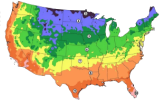Snow Queen Nectarine Tree
The Snow Queen nectarine tree reigns as a taste test winner, celebrated for its exceptional qualities. This sweet and juicy early-season white freestone delights palates with its succulent flavor. Harvested in late June in Central California, it ripens an impressive 2-3 weeks ahead of the Babcock peach, making it an eagerly awaited treat. A long-time favorite in Southern California, this nectarine tree thrives in the region's warm climate. With a low chilling requirement of 250-300 hours, it ensures a fruitful harvest, and being self-fruitful adds to its appeal as a valuable addition to any garden or orchard.
Snow Queen Nectarine Trees Fruit Description:
The Snow Queen nectarine boasts a royal allure with its luscious white freestone flesh. Exuding natural sweetness and juiciness, it pleases the palate with a delightful burst of flavor. Its early-season harvest makes it an irresistible delight for fresh consumption and culinary creations alike.
Snow Queen Nectarine Tree Description:
The Snow Queen nectarine tree graces the landscape with elegance and charm. Its blossoms herald the arrival of Spring, showcasing a captivating display of beauty and fragrance. The tree's lush green leaves form a vibrant canopy, providing a welcoming shade in warmer months. Beneath the soil, the well-established root system ensures stability and efficient nutrient uptake, promoting its robust growth and productivity. The smooth bark adds to the tree's overall visual appeal.
Uses:
The Snow Queen nectarine is a culinary gem, perfect for a variety of uses. Its sweet and juicy flesh elevates the joy of enjoying fresh, ripe nectarines during the early season. These nectarines are excellent additions to fruit salads, smoothies, and desserts, infusing them with their delightful flavor and eye-catching white flesh. Their early harvest also makes them ideal candidates for preserving in jams and preserves, capturing their essence for year-round enjoyment.
History
The Snow Queen nectarine's storied history is rooted in its triumph as a taste test winner, earning it esteemed recognition for its outstanding flavor. It's early-season nature and white freestone characteristics have made it a cherished favorite in Southern California, captivating the taste buds of fruit enthusiasts for generations. As a low-chill nectarine variety, it thrives in regions with milder winters, contributing to its widespread popularity. Being self-fruitful ensures a reliable harvest, and its versatility in culinary uses makes it a valuable choice for both home gardeners and commercial growers.
The history of nectarines and their various types is a fascinating journey that stretches back thousands of years. Despite its botanical name “Prunus Persica” linking it to Iran, genetic studies indicate that nectarines originated in China. While early cultivation was believed to have started around 2000 BC, recent evidence points to an even earlier origin in China’s Zhejiang Province, dating back to 6000 BC. From China, nectarines made their way to West Asia and Iran, where they were cultivated and appreciated for their unique qualities. Subsequently, they were introduced to Greece and Rome, becoming cherished fruit in these ancient civilizations. The allure of nectarines continued to spread, reaching northern Europe and England by the sixteenth century, capturing the hearts of people across various regions.
In the course of history, nectarines crossed the oceans and found their way to the United States, thanks to the efforts of the Spaniards who brought and planted them in California. This marked the beginning of nectarine cultivation in the United States, where they flourished in the sunny climate of California, contributing to the diversity of fruits available to Americans. Throughout the centuries, nectarines have undergone further cultivation and breeding, leading to the development of various types with distinct characteristics. Today, numerous nectarine varieties exist, each offering its own flavor, texture, and appearance. From traditional yellow freestone nectarines to white nectarines, each type holds a special place in the hearts of fruit enthusiasts and continues to be enjoyed worldwide. The journey of nectarines from their ancient origins in China to their spread across continents highlights the enduring appeal of this delectable fruit. As its popularity continues to grow, the history of nectarines stands as a testament to the appreciation of nature’s bounties and the ingenuity of human efforts to cultivate and cherish these remarkable fruits.
Spacing Between Trees:
- Standard-sized fruit trees typically require spacing of 20 to 25 feet between each tree.
- Semi-dwarf varieties may need spacing of 15 to 20 feet, while dwarf fruit trees can be spaced closer, around 10 to 15 feet apart.
- If planting multiple rows of fruit trees, maintain spacing between rows to allow for adequate sunlight penetration and airflow.
- Rows should typically be spaced 25 to 30 feet apart for standard-sized trees, and 15 to 20 feet apart for semi-dwarf and dwarf varieties.
- Consider the mature height and spread of the fruit trees when determining spacing.
- Ensure enough space between trees and other structures to accommodate their growth without crowding.
- Plant fruit trees in rows with the north to south orientation to maximize sunlight exposure on both sides of the trees.
- Avoid planting fruit trees too close to buildings, fences, or other structures, as their roots may cause damage over time.
- Prepare the planting area by loosening the soil and incorporating organic matter to improve drainage and fertility.
- Plant fruit trees at the same depth as they were in the nursery container, ensuring that the graft union (if present) is above the soil level.
Step One:
Soil and Planting: Plant in soil that drains well. Dig a hole that is as deep as the tree’s roots and at least twice as wide.
Step Two:
Place the tree in the hole and backfill around the plant’s roots with a mixture of the native soil and high-quality planting mix that has washed sand and organic fertilizer.
Step Three:
Create a basin around the roots drip zone so that water collects. Water deeply until the roots and nearby soil is saturated and reaches field capacity.
Full Sun Exposure:
- Most fruit trees thrive in full sun, which typically means they need at least 6 to 8 hours of direct sunlight each day.
- Choose a planting location that receives ample sunlight throughout the day, preferably in a spot with southern or western exposure.
- Sunlight is essential for photosynthesis, the process by which plants convert sunlight into energy to fuel growth and fruit production.
- Adequate sunlight promotes healthy leaf development, flowering, and fruit ripening in fruit trees.
- Avoid planting fruit trees in areas with excessive shade from buildings, tall trees, or other structures, as this can inhibit growth and reduce fruit production.
- Trees planted in shaded areas may produce fewer fruits, have slower growth rates, and be more susceptible to diseases and pests.
- Ensure that fruit trees are spaced appropriately to allow sunlight to reach all parts of the tree, including the canopy, branches, and fruiting spurs.
- Prune surrounding trees or shrubs that may shade fruit trees and obstruct sunlight.
- Monitor changes in sunlight exposure throughout the year, as seasonal variations in sun angle and tree foliage can affect light availability.
- Adjust planting locations or prune surrounding vegetation as needed to maintain optimal sunlight exposure for fruit trees.
Establishment Period:
- During the first year after planting, fruit trees require regular watering to establish strong root systems.
- Water newly planted fruit trees deeply and frequently, providing enough moisture to keep the soil consistently moist but not waterlogged.
- In general, fruit trees should be watered deeply once or twice a week, depending on soil type, weather conditions, and tree species.
- Adjust the frequency of watering based on rainfall, temperature, and soil moisture levels to prevent both under-watering and over-watering.
- Water fruit trees deeply to encourage deep root growth and drought tolerance.
- Apply water slowly and evenly to ensure that it penetrates the soil to a depth of at least 12 to 18 inches.
- Use drip irrigation, soaker hoses, or watering bags to deliver water directly to the root zone of fruit trees, minimizing water loss through evaporation and runoff.
- Avoid overhead watering, as it can promote fungal diseases and waste water by spraying foliage instead of reaching the root system.
- Water fruit trees in the early morning or late afternoon to reduce water loss through evaporation and minimize stress on the trees during the hottest part of the day.
- Avoid watering fruit trees during windy or extremely hot conditions, as water may evaporate quickly before it can be absorbed by the roots.
- Monitor soil moisture regularly by checking soil moisture levels with a moisture meter or by conducting a simple soil moisture test using your finger.
- Adjust watering practices based on soil moisture levels and weather conditions to ensure that fruit trees receive adequate moisture throughout the growing season.
- During periods of drought or prolonged dry spells, increase the frequency and duration of watering to prevent drought stress and maintain tree health.
- Consider applying a layer of mulch around the base of fruit trees to conserve soil moisture and reduce water loss through evaporation.
Timing of Fertilization:
- Fertilize fruit trees in early spring, just before new growth begins, to provide essential nutrients for the upcoming growing season.
- Avoid fertilizing fruit trees late in the growing season, as it may stimulate late-season growth that is susceptible to winter damage.
- Choose a balanced fertilizer specifically formulated for fruit trees, such as a 10-10-10 or 12-12-12 NPK (nitrogen, phosphorus, potassium) fertilizer.
- Consider using organic fertilizers, such as compost, aged manure, or organic fertilizer blends, to promote soil health and reduce the risk of chemical buildup.
- Apply fertilizer evenly around the base of the fruit tree, extending beyond the drip line of the branches.
- Avoid placing fertilizer directly against the trunk of the tree, as it may cause root burn or damage to the tree.
- Follow the recommended application rates provided on the fertilizer label or based on the specific needs of the fruit tree species and soil conditions.
- Use caution not to over-fertilize fruit trees, as excessive nitrogen can lead to excessive vegetative growth at the expense of fruit production.
- Water the fruit tree thoroughly after applying fertilizer to help dissolve and distribute the nutrients into the soil.
- Adequate moisture is essential to ensure that the roots can absorb the nutrients from the fertilizer effectively.
- For established fruit trees, fertilize once a year in early spring, unless soil tests indicate a specific nutrient deficiency that requires additional fertilization.
- Young or newly planted fruit trees may benefit from lighter, more frequent applications of fertilizer during the first few years to support growth and establishment.
- Periodically conduct soil tests to assess nutrient levels and pH balance, as well as to determine the specific fertilizer needs of fruit trees.
- Adjust fertilization practices based on soil test results to ensure that fruit trees receive the appropriate nutrients for optimal growth and fruit production.
Timing of Pruning:
- Prune fruit trees during the dormant season, typically in late winter to early spring before new growth begins.
- Avoid pruning fruit trees during periods of active growth or in late fall, as it may stimulate new growth that is vulnerable to winter damage.
- Use sharp, clean pruning tools, such as hand pruners, loppers, and pruning saws, to make clean cuts and minimize the risk of disease transmission.
- Disinfect pruning tools between each tree to prevent the spread of pathogens.
- Remove dead, diseased, or damaged branches to improve the overall health and appearance of the fruit tree.
- Thin out crowded or crossing branches to improve air circulation and sunlight penetration within the canopy.
- Shape the tree to promote an open, well-structured canopy that allows for even fruit production and easy harvesting.
- Begin by removing any dead, diseased, or broken branches, making clean cuts just outside the branch collar (the swollen area where the branch meets the trunk).
- Thin out excessive growth by selectively removing crowded or crossing branches to allow for better light and air distribution.
- Use heading cuts to prune back overly vigorous branches to encourage branching and promote fruiting wood formation.
- Consider the fruiting habit of the tree species when pruning, as some fruit trees produce fruit on spurs (short, stubby branches) while others bear fruit on new growth.
- Train young fruit trees by selectively pruning to establish a strong, well-balanced framework of scaffold branches.
- Encourage outward growth by pruning back inward-growing branches and removing competing leaders to maintain a central leader or open-center shape.
- Different fruit tree species may have specific pruning requirements based on their growth habits, fruiting patterns, and desired form.
- Research the specific pruning needs of the fruit tree species you are growing and tailor your pruning practices accordingly.
- Monitor the fruit tree throughout the growing season for any additional pruning needs, such as removing water sprouts or suckers that may develop.
- Regularly inspect the tree for signs of pests, diseases, or other issues that may require pruning intervention.
- Monitor for Pests:
- Regularly inspect fruit trees for signs of pest infestation, such as chewed leaves, distorted growth, or the presence of insects or larvae.
- Keep an eye out for common fruit tree pests, including aphids, scale insects, mites, caterpillars, and fruit flies.
- Cultural Practices:
- Maintain good cultural practices, such as proper pruning, watering, and fertilizing, to promote healthy, resilient fruit trees that are better able to withstand pest attacks.
- Remove and destroy any fallen fruit, leaves, or other plant debris that may harbor pests or disease pathogens.
- Natural Predators:
- Encourage natural predators of pests, such as ladybugs, lacewings, and predatory wasps, by providing habitat and avoiding the use of broad-spectrum pesticides that may harm beneficial insects.
- Plant flowering plants nearby to attract pollinators and beneficial insects that help control pest populations.
- Physical Barriers:
- Install physical barriers, such as tree wraps or trunk guards, to protect fruit trees from crawling pests like ants and rodents.
- Use floating row covers or netting to exclude flying insects, birds, and other pests from accessing fruit trees.
- Biological Control:
- Consider using biological control methods, such as releasing beneficial nematodes or predatory insects, to target specific pests while minimizing harm to non-target organisms.
- Introduce parasitic wasps, predatory mites, or other natural enemies of pest insects to help control populations without the need for chemical pesticides.
- Integrated Pest Management (IPM):
- Implement an integrated pest management (IPM) approach that combines multiple pest control strategies, including cultural, biological, physical, and chemical methods, to effectively manage pest populations while minimizing environmental impact.
- Monitor pest populations regularly and use thresholds to determine when intervention is necessary, prioritizing the use of non-chemical control methods whenever possible.
- Selective Pesticide Use:
- Use chemical pesticides as a last resort and only when non-chemical methods have proven ineffective or when pest populations exceed acceptable thresholds.
- Selectively choose pesticides that are least harmful to beneficial insects, pollinators, and the environment, and follow label instructions carefully to minimize risks to human health and the ecosystem.







